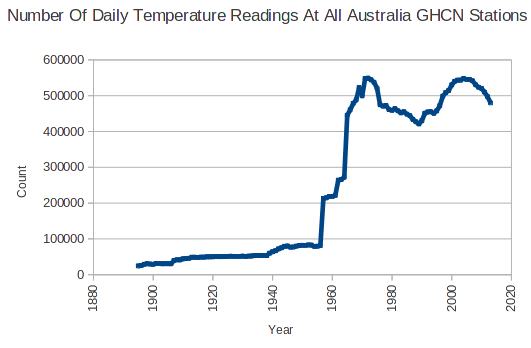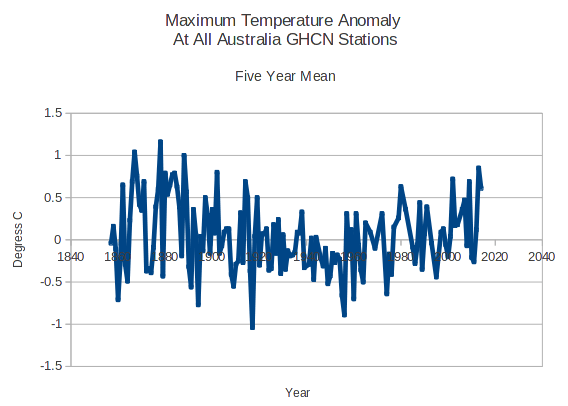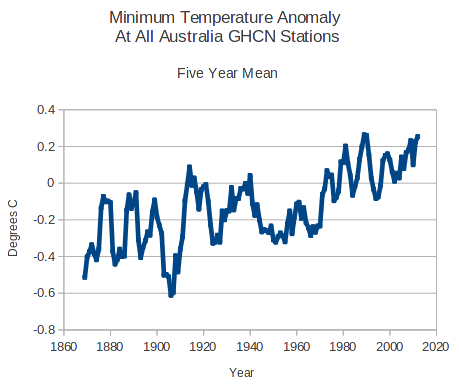The absolute temperature graphs I posted earlier show that there are some serious discontinuities in the Australian temperature record. There was a huge increase in the number of temperature readings, immediately after 1956.
Because the Australian record is so fragmented, I tried generating anomaly graphs (daily anomaly from the monthly mean at that station.) Here are a couple of interesting graphs, for maximum and minimum anomalies.
The maximum anomalies peaked in 1878, declined until the 1950s, and have been rising ever since.
Minimum anomalies have been rising steadily for the entire temperature record. Possible UHI effects.
What does it mean?





Watch Andrew Bolt roast all the Australian global warmers. See the lie busting shot of the Brisbane dam releasing water.
https://www.youtube.com/watch?v=s9voS5MJSuM
Good God! The disease is more widespread than I thought! My local news must have now received the memo because they just stated the Polar Vortex this winter was caused by global warming. The epidemic is here and now….
The answer, in my view, lies in the range of the anomalies (the y-axis in both graphs). As I have said here a number of times before, it looks like the long term trend, both regionally (as in Australia or the USA) and globally, is a constant long-term mean surface temperature (varying from one climate region to another, of course), with a natural variability of about 0.5°C above and below that mean. The 45-year recent rise in the minimum Australian temperature (about 1970 to present) only encompasses 0.4°C.
I want to post it, but you can go look it up on YouTube: Won’t Get Fooled Again by the Who.
Demographics.
Where did all the vets go after WW2?
Home to create the baby boomers…
Many of them dropped out of animal medicine practice completely.
🙂
Looks like UHI. The older stations are probably in major cities and the newer stations are more rural.
Beat me to it
nuclear testing
patio heaters
multiple tobs
error in the sql group by statement (most likely imho)
It means the Australian dataset, called ACORN, is unreliable and a joke.
Ken Stewart and Jennifer Marahosy ( and others) have been working on this for years.
We are only just starting to scratch the surface on this scam.
Keep up the good work Tony.
Don’t forget Jo Nova. Looks like ACORN is a real mess. (Acorn is an ADJUSTED data set BTW)
BOMs new data set, ACORN, so bad it should be withdrawn (954 min temps larger than the max!)
June 2012 Threat of ANAO Audit means Australia’s BOM throws out temperature set, starts again, gets same results by Joanne Nova and Ken Stewart
Here for comparison is the (detrended) HadCRUT4 graph.
http://www.woodfortrees.org/plot/hadcrut4gl/from:1850/trend/detrend:0.778/plot/hadcrut4gl/mean:120/detrend:0.778
It appears to bear some resemblance to the min. anomalies inasmuch as it appears to have a ~60 year periodic element, the max. anomalies, on the other hand…
Mmmm… Curious.